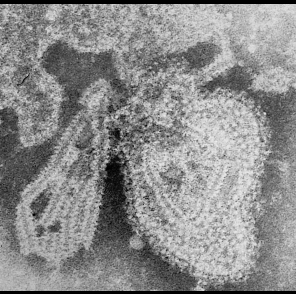Mumps virus
|
Mumps Microchapters |
|
Diagnosis |
|---|
|
Treatment |
|
Case Studies |
|
Mumps virus On the Web |
|
American Roentgen Ray Society Images of Mumps virus |
| style="background:#Template:Taxobox colour;"|Template:Taxobox name | ||||||||
|---|---|---|---|---|---|---|---|---|
 TEM micrograph of the mumps virus.
| ||||||||
| style="background:#Template:Taxobox colour;" | Virus classification | ||||||||
| ||||||||
| Type species | ||||||||
| Mumps virus |
Editor-In-Chief: C. Michael Gibson, M.S., M.D. [1]; Associate Editor(s)-In-Chief: Lakshmi Gopalakrishnan, M.B.B.S. [2]
Overview
Mumps is caused by a paramyxovirus, and transmission of the virus occurs via respiratory secretions such as infected saliva, air droplets or via direct contact with articles that have been contaminated with infected saliva. The incubation period is usually 18 to 21 days. Infected patients remain contagious from approximately 6 days before the onset of symptoms until about 9 days after the onset of symptoms.
Organism
Mumps is caused by a paramyxovirus, and transmission of the virus occurs via respiratory secretions such as infected saliva, air droplets or via direct contact with articles that have been contaminated with infected saliva.
Mumps is generally a mild illness among pediatric population in developed countries. The incubation period is usually 18 to 21 days, but may range from as few as 12 to as many as 35 days.[1] Infected patients remains contagious from approximately 6 days before the onset of symptoms until about 9 days after the onset of symptoms.
Human Pathogen
Related Chapters
References
- ↑ Conly J, Johnston B (2007). "Is mumps making a comeback?". The Canadian Journal of Infectious Diseases & Medical Microbiology = Journal Canadien Des Maladies Infectieuses Et De La Microbiologie Médicale / AMMI Canada. 18 (1): 7–9. PMC 2542890. PMID 18923686. Unknown parameter
|month=ignored (help);|access-date=requires|url=(help)